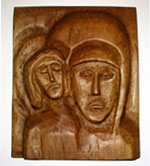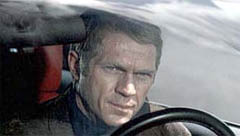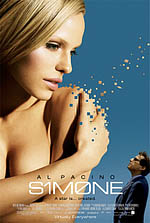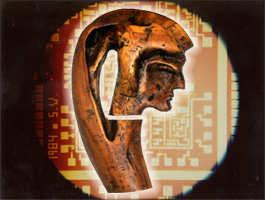"...an expression of one's soul."
It has been said, "Art is an expression of one's soul." The statement is especially true when art is produced to fulfill a personal creative need and is not simply a project for hire. Sometimes a creative piece can be so profound that it acquires a level of expression exceeding our own consciousness, conveying not only an image or a concept, but also the ability to touch the viewer's soul.
Low Tech Art vs. High Tech Art
 
|
|
[Sculpture: Peppe Orlando - Italy]
|
Though this column is usually very enthusiastic regarding high-tech, low-tech art, utilizing more traditional tools and methods, is perhaps the more expressive and the more beautiful. Today we are bombarded by images of perfection. Magazine covers and advertising images have become "perfect" -- i.e. fashion models in photos have no creases, natural body fat is edited out and skin is made to look flawless -- an apple is made redder; orange skins have no texture deviations and bananas are a perfect yellow...
With a computer even a small child can produce perfect pictures, with smooth lines, straight edges and nice even curves. Because the rendering device is so sophisticated, the child' s true manual ability to create has been enhanced, so much so, that the image that he or she has created has more to do with the computer assistance than with the child's hand. This doesn't diminish the child's idea of creating an image, but somehow the product seems less genuine than a cute, albeit crooked, drawing that he or she would produce using crayons and paper...
So how does this fit in with technology and art?


|
Actor Steve McQueen was featured in a Ford Mustang commercial over 20 years after his passing.
[Photo: Ford Motor Co.]
|
Well the obvious answer is that new programs and software are being produced everyday, which allow artists to create images and objects that have, up until now, either been dreams or beyond comprehension. The various media that are being employed today are allowing all of the various art disciplines to enter territories that were only thoughts ten years ago. For the last several years it has been possible to extract images from old movies and digitally add them into new scenes. We have long dead movie stars appearing in commercials selling beer to driving new cars. Thus far we've just scratched the surface.
Dead Actors Acting in New Films?
It is now possible to create digital images of long dead movie stars, acting in new motion pictures. Let's take a well-known movie star of the past such as Clark Gable. If we were to take every existing frame of film footage, as well as, every sound byte produced by Mr. Gable and database it, software could rebuild a digital Clark Gable that could be manipulated to say or do almost anything.


I'm not talking about reusing existing footage, but rather taking every movement, gesture and nuance and building new combinations of movement based on the databased information. Rhythmic and inflection analysis could produce the proper timing to give the digital Clark Gable the ability to mimic characteristic movement or even invent new movement based on the data and deliver new lines in such a natural manner that it would be very difficult to distinguish the digital from the original actor. Many of these past actors could become more productive and profitable after life than they were while they were alive.
Creating perfection...
A few years ago Al Pacino starred in a movie called "Simone" about a completely virtual actress created by software. Simone was a composite of the many different ideal attributes of real actresses. She was considered to be perfect. The movie was a "dramedy" and though it contained a number of interesting situations, it left many issues unaddressed and questions unasked. The film was a box-office "under-achiever" thus a similar project asking more poignant questions may never happen. The fictional technology of that 2002 film is so close to reality now that a "real" and convincing virtual Simone-like actor may appear soon.
Back to the topic... art and technology...
...sometimes the proximity of the hand to the finished product can be most compelling.


|
|
[Sculpture: Peppe Orlando - Italy]
|
While computerized forms of art are creating awe and flawless ideals, more traditional art forms will no-doubt become more interesting -- the same way that a "hand-addressed" envelope gets more attention these days than a machine-produced address label. Less perfection can be perfect, in that some things can almost be better conveyed through more traditional methods. A painter's stroke or a sculptor's finish -- each can make a connection with the viewer on a more visceral almost ethereal level. While the machine can produce ideals and perfection -- eventually it also produces a clinical sterility. It is very easy to get caught up in the excitement of the technological advancements that have been made in art production. It does allow us to delve into creative areas that are yet to be discovered, but it is equally important to realize that sometimes the proximity of the hand to the finished product can be most compelling.
Gigliotti, Lorenzo. "Art and Technology, Less Perfection is Perfect." The Random Times
Volume 1. #21 (2005): 7 pars. 07 Dec. 2025 <http://www.therandomtimes.com>.





